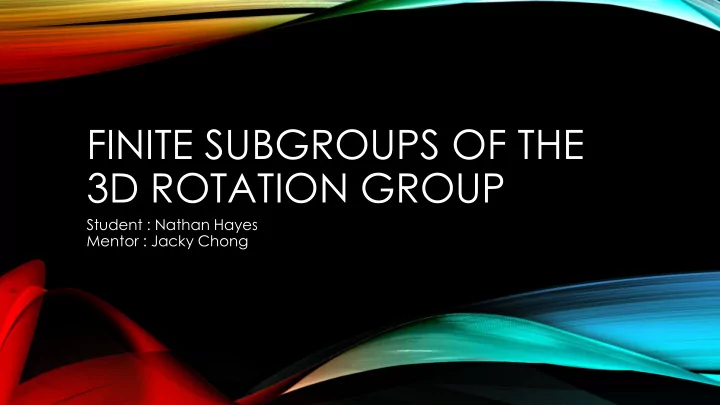

FINITE SUBGROUPS OF THE 3D ROTATION GROUP Student : Nathan Hayes Mentor : Jacky Chong
SYMMETRIES OF THE SPHERE • Let’s think about the rigid rotations of the sphere. • Rotations can be composed together to form new rotations. • Every rotation has an inverse rotation. • There is a “non - rotation,” or an identity rotation. • For us, the distinct rotational symmetries of the sphere form a group, where each rotation is an element and our operation is composing our rotations. • This group happens to be infinite, since you can continuously rotate the sphere. • What if we wanted to study a smaller collection of symmetries, or in some sense a subgroup of our rotations?
THEOREM • A finite subgroup of SO 3 (the group of special rotations in 3 dimensions, or rotations in 3D space) is isomorphic to either a cyclic group, a dihedral group, or a rotational symmetry group of one of the platonic solids. • These can be represented by the following solids : Cyclic Dihedral Tetrahedron Cube Dodecahedron • The rotational symmetries of the cube and octahedron are the same, as are those of the dodecahedron and icosahedron.
GROUP ACTIONS • The interesting portion of study in group theory is not the study of groups, but the study of how they act on things. • A group action is a form of mapping, where every element of a group G represents some permutation of a set X. • For example, the group of permutations of the integers 1,2, 3 acting on the numbers 1, 2, 3, 4. So for example, the permutation (1,2,3) -> (3,2,1) will swap 1 and 3. • An orbit is a collection of objects that can be permuted by the actions of the group. • Under our example action, the orbit of 1 is {1, 2, 3}, while the orbit of 4 is {4}. • A stabilizer is a collection of group elements that send a given set element onto itself. • Under our example action, the stabilizer of 1 is only the group element {(1,2,3)->(1,2,3)}, while the stabilizer of 4 is the full group.
PROOF (SKETCH) • Let G be a finite subgroup of SO 3 . Each element of G represents a rotation of 3D space about an axis that passes through the origin, besides the identity rotation. • We define the poles of a rotation g in G to be the two points on the unit sphere to be left fixed by g acting on 3D space. • Let X denote the set of all poles of all elements of G, our subgroup, other than the identity element. • We have an action of G on X.
PROOF (COUNTING ARGUMENT) • Let N denote the number of distinct orbits, and choose a pole for each orbit. Call these x 1 , x 2 , … x n . Every element of G – {e}, the identity, fixes exactly 2 poles, while the identity fixes them all. • Here, we use the Counting Theorem : • The number of distinct orbits of group G acting on set X is equal to • Where |X g | is the number of elements of X left fixed by group element G. • For this group action, using the property above, we have :
PROOF (BOUNDS ON N) • With some algebraic manipulation of the last expression, we are left with : 𝑂 2 1 − 1 1 = 1 − 𝐻 𝑡𝑢𝑏𝑐𝑗𝑚𝑗𝑨𝑓𝑠 𝑦 𝑗 𝑗=1 • Assuming G is not the trivial group {e} of size 1, the left size of the equation must be greater than or equal to 1 and less than 2, since |G| > 1. • In addition, each stabilizer has order at least 2 (the poles), so each term of the sum on the right is greater than or equal to ½ and less than 1. • Thus, N is either 2 or 3.
PROOF (CASES) • If N = 2, then we have 2 = |G(x 1 )| + |G(x 2 )|, and there can only be 2 poles. Every element in G must therefore rotate around the axis formed by these two poles, and the plane perpendicular to this axis is mapped onto itself. Therefore, G is isomorphic to a rotation in 2 dimensions and is a cyclic group. • If N = 3, we have through some algebraic manipulation : • Note that the terms |G x |, |G y |, and |G z | must be integers and that the right hand side of the equation must be greater than 1, so we have a set of possible solutions :
PROOF (MORE CASES) • By continuing through the casework, we have the following : • If we are in situation (a), with 1/2, 1/2, 1/n, we have a dihedral group. • In situation (b), with 1/2, 1/3, 1/3, we have a regular tetrahedron. • In situation (c), with 1/2, 1/3, 1/4, we have the vertices of a regular octahedron, and equivalently the faces of a cube. • In situation (d), with 1/2, 1/3, 1/5, we have the vertices of a regular icosahedron, and equivalently the faces of a dodecahedron. • These are therefore all of the finite subgroups of the group of rotations on 3 dimensions.
CREDIT • Jacky Chong, mentor • Naïve Lie Theory, by John Stillwell, reference textbook • Groups and Symmetry, by M. A. Armstrong, reference textbook, images
Recommend
More recommend